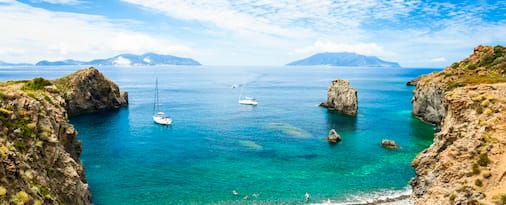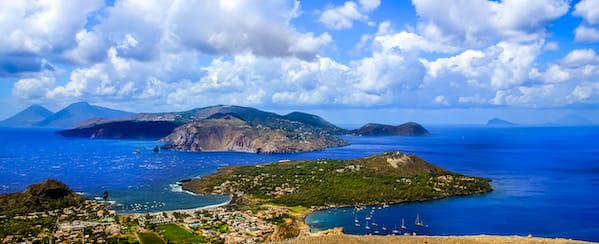
Aeolian Islands – 7 day itinerary
1. Transfer to Lipari
Embark in Milazzo or Capo d’Orlando and transfer from Sicily to Lipari, the largest island in the Aeolian archipelago declared by UNESCO as a World Heritage Site. Mooring at anchor, dinner, and overnight facing the suggestive Castello di Lipari (Lipari Castle) overlooking the sea.
Lipari Castle stands at the top of the Acropolis and is a real fortified citadel on a volcanic fortress about 50 meters high dominating the Tyrrhenian Sea. It is a village of prehistoric origins and the Castle dates back to the year 837.
2. Lipari and its coves
After breakfast, the day can be dedicated to discovering the Lipari island coast and its wonderful coves. After leaving the Castle of Lipari, make the first stop at the Cave Della Pomice for a refreshing swim.
Set off in the direction of Canneto where it is possible to have lunch at anchor and then continue and skirt Acquacalda. In the evening move to Salina, the second largest island of the Aeolian archipelago.
3. Salina
Marina di Salina is the most important municipality on the island and is characterized by a beautiful church, Santa Marina, decorated with splendid ancient majolica tiles. We recommend that you go ashore and visit the church and do some shopping in the local shops and maybe taste the typical wine “Malvasia“. Leaving again, cruise the eastern side of the island and stop for a swim in the beautiful bay of Pollara, made famous by Massimo Troisi’s movie “The Postman”. In the afternoon stop in Lingua, a small and charming fishing village, with its salt lake which gave this island its name. If you have a sweet tooth, we recommend a stop at the famous little bar “Alfredo” to taste the typical “pani cunzatu” and delicious granitas.
Dinner aboard the yacht in the Rinella cove. Night transfer to Vulcano.

4. Vulcano
Waking up and having breakfast with the island of Vulcano as a backdrop is something wonderful and stunning. We start the day from Vulcanello, where the lava has created fantastic shapes: the suggestive Valley of the Monsters. Leaving the Faraglioni and the Grotta degli Angeli on the right, you can admire the Sabbie Nere (Black Sands) bay, renowned for its very long volcanic sand beach, and the active volcano of the island: the massive Gran Cratere della Fossa. Then, we continue to the Grotta del Cavallo (the Horse Cave), skirting Scoglio delle Sirene (the mermaid rock), Punta Cala del Formaggio, Capo Grosso, Punta del Monaco, Punta della Sciarra del Monte, and then arriving at the Piscina di Venere, a very suggestive circular shallow water. Lunch in the harbor and then continue to coast along the island of Vulcano and arrive in Gelso, a small almost uninhabited village where you can also stop there for a swim at the Gelso beach or Punta dell’Asino beach and visit the place.
We finish the day at the port of Levante where you will be greeted by the acrid smell of sulfur. If you love thermal places, you can swim in the mud pool, in the warm waters, or in the geothermal pools. You can go ashore in the evening and take a tour of the pretty village. For the more sporty guests, the climb to the crater is not to be missed!
5. Panarea and Stromboli
We arrive in Panarea, where we will visit the natural bay of Calajunco, above where the prehistoric village of Capo Milazzese is located. We stop in the adjacent Cala Zimmari for a swim and then leave for a small panoramic tour among the islets and visit the Lovers’ Cave (Grotta degli Innamorati). Landing on the island of Panarea, you can visit the Church of S. Pietro from which you can enjoy a breathtaking panoramic view. Continuing the road, you reach the prehistoric village. Alternatively, we suggest taking a walk through the refined alleys and enjoy a delicious granita in one of the many small bars facing the sea.
In the afternoon we head to the island of Stromboli where you can admire the small Ginostra and the Strombolicchio, a colossal rock. A stop for a swim in the cobalt-colored waters cannot be missed. For the more curious, it is possible to visit the delightful village of the island up to the house where Ingrid Bergman stayed during the shooting of “Stromboli, Land of God” and where love was born with Rossellini. You can then dine on board or in the village and stroll around the shops and magnificent gardens. It is exciting to watch the sunset under the Sciara del fuoco, a steep slope crossed by lava streams. You can watch from the sea the magnificent show of the volcano gives you exploding in a symphony of reddish lapilli.
6. Filicudi and Alicudi
We expect a crossing from Stromboli to Filicudi. We pass next to the Faraglioni, leaving the island of Salina on the right. We arrive near the Grotta del Bue Marino where you will have an unforgettable swim! Then we approach the Faraglioni: Montenassari, Giafante, and Canna, a very particular volcanic lava neck, 85m high. It is possible to stop at the port and visit the prehistoric village of Capo Graziano and the village.
In the afternoon we head towards Alicudi, but not before a short stop along the coast to see the ancient mill wheels. Alicudi is the least populated island of the archipelago, which has remained unspoiled by mass tourism. If you want to go ashore, strolling along the mule track that runs through it, will take you back in time and a nice refreshing bath is a must here.
7. Lipari and return to Milazzo
Transfer to Lipari, skirting the western, more rocky side of the island. For culture lovers, we recommend you to visit the Acropolis of Lipari, the Castle, the Cathedral with the attached Cloister, and the Archaeological Museum. For wine lovers, a visit to a renowned wine cellar, a walk through the vineyards, and wine tasting admiring the sun setting on the beautiful islands of Alicudi, Filicudi, and Salina. At the end of the day, return to Milazzo / Capo d’Orlando.
8. Disembark





